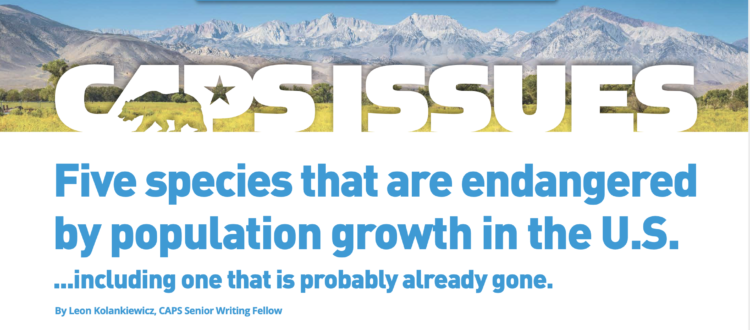Five species that are endangered by population growth in the U.S. …including one that is probably already gone.
Published on October 30th, 2020
PDF Download: Five species that are endangered by population growth in the U.S.
Five species that are endangered by population growth in the U.S. …including one that is probably already gone.
By Leon Kolankiewicz, CAPS Senior Writing Fellow
October, 2020
Living organisms depend on not just generic space, resources, and energy to survive and thrive, but on particular habitats, those lands and waters endowed with the precise biophysical attributes that a given species requires. Humans com- pete with myriad other species of organ- isms for these favorable environments.
Every additional human being places additional strain on an already overstressed ecosystem. As a rule, when human population increases, wildlife populations decrease. It’s really almost that simple: what mathematicians and scientists call an inverse relationship or correlation. And in this case, however, it is not mere correlation, but causation as well, not merely coincidental. Human population growth causes a decline in the abundance and diversity of wild living things, both flora and fauna.

California is recognized as one of the Earth’s “biologically diverse hotspots” (iStock)
With America’s population at 330 million and growing, human population pres- sures on wildlife continue to mount. The Endangered Species Act, signed into law by President Nixon in 1973, now includes 1,275 species and subspecies of plants and animals as endangered (at imminent risk of extinction in the wild) and another 388 as threatened (at risk of becoming en- dangered). Being listed entitles a species to protections and initiatives that substan- tially increase its prospects for survival. One measure is designating “critical habitat” deemed crucial for an imperiled population’s recovery.
“California is the ‘wildlife’ state,” I wrote in an op-ed for the Los Angeles Daily News. “It boasts more species than any other, as well as the greatest number of endem- ics….This extraordinary biodiversity is already stressed by the state’s enormous human population and further threatened by continuing rapid population growth and development.”
Sadly, I pointed out: “California also claims the dubious distinction as the state with the most imperiled wildlife.” The most populated state and the most threatened and endangered (listed) species. Hmm. Is that merely coincidence? Of course not.
California is recognized by conservation- ists and scholars alike as one of the Earth’s “biodiversity hotspots.” The California Academy of Sciences points out that the
state’s “unique habitats have produced
a rich mosaic of life. Many plants and animals here are found nowhere else, making California one of the most biologically diverse places in the world.” Unfortunately, according to the Academy, “some of the most spectacular places on earth are also the most threatened.” As the most populous state by far and one of the fastest growing states, the protec- tion of California’s unique biodiversity is a challenge, to put it mildly.
The California Department of Fish and Wildlife (DCFW) notes, “Increasing needs for housing, services, transportation, and other infrastructure place ever-greater demands on the state’s land, water, and other natural resources.” Of course, each of these habitat stressors is linked with population growth.

Male adult California gnatcatcher in its summer breeding plumage (U.S. Fish and Wildlife Service)
Let’s look at five species in America for which this pathological growth has proved not a blessing, but a curse.
California Gnatcatcher
(Polioptila californica californica)
The coastal California gnatcatcher is a petite, blue-gray songbird in the old- world warbler and gnatcatcher Sylviidae family. It is less than five inches long and its weight is best measured in grams (just six) and not ounces. Despite its dainty size, the California gnatcatcher is known to mob much larger birds that are potential nest predators, such as the roadrunner, California scrub-jay, and cactus wren. Mobbing these bigger birds perturbs them and drives them away from vulnera- ble nestlings.
The feathers on its back are dark blue- gray feathers and grayish-white on its underside, while the wings are brownish. Both males and females have a white ring around their eyes. Males sport a black cap during the breeding season.
It feeds mostly on small spiders and insects, including true bugs, beetles, caterpillars, scale insects, wasps, ants, flies, moths, small grasshoppers, and of course, gnats. It may also eat small berries. One of the gnatcatch- er’s adaptations to a semi-arid environment with few perennial surface streams is clean- ing its feathers by using water deposited on leaves by rain or coastal fog.
The gnatcatcher is found in just six counties in Southern California (Ventura, Los Angeles, Orange, San Diego, San Bernardino, and Riverside) and a tiny sliver of Mexico. It is dependent on coastal sage scrub habitat, an estimated 60-90 percent of which has disappeared under the infa- mously sprawling suburbs, subdivisions, and freeways of Southern California. Mas- sive population growth since World War II is the main driver of this sprawl.
The U.S. Fish and Wildlife Service (USFWS) designated the California gnatcatcher as threatened in 1993 and it remains so today, in spite of increasingly coordinated interagency efforts to protect its habitat from encroaching development in Southern California. Natural Community Conservation Plans (NCCPs) are innovative approaches to protecting important hab- itats that engage the participation of both private and public sector “stakeholders.”
The Orange County Central and Coastal Subregions NCCP and Habitat Conservation Plan (HCP) was approved in 1996. It protects more than 37,000 acres (almost 60 square miles) of the California gnatcatcher’s coastal sage scrub habitat in one of California’s most populous counties, helping conserve 39 listed and unlisted species of concern. The benefit for the big local developer, The Irvine Company, of funneling development into pre-approved areas is avoiding costly delays while the USFWS reviews develop- ment proposals for their potential effects on listed species.
Some 27 NCCP’s have now been approved or are under development in California. They represent an enlightened effort
or reasonable compromise approach that allows managed population growth and development to proceed while still permitting a high degree of wildlife and bio- diversity conservation that at a minimum prevents imperiled species from being driven to outright extinction.
CDFW has claimed sensibly: “Without conservation planning, growth and devel- opment can eliminate important habitats.” That is, we can have our cake and eat it, too. A more honest, less politically correct rendering would be: “Even with conserva- tion planning, growth and development will eliminate important habitats.” Good planning is crucial to managing the ill effects of perpetual population growth, but it is not a panacea.
Mission Blue Butterfly
(Icaricia icarioides missionensis)
When considering biodiversity, it is not just the large creatures that matter, but all crit- ters great and small. “Charismatic” species such as pandas, elephants, tigers, whales, and eagles all have something in common with us. They are all vertebrates – animals with backbones – like we humans are. They also possess larger brains and social lives, care for their young, and other traits that we admire and can relate to. But the tiny critters without backbones – invertebrates – they matter too. Immensely.
Author Jacob Mikanowski notes in The Guardian that insect species are being “swept away in an ecological catastro- phe that has come to be known as the sixth extinction.” Invertebrates in general and especially the insects – those arthro- pods that famed entomologist E.O. Wilson calls “little things that run the world” – are bearing the brunt of the global extinction crisis. “Everywhere, invertebrates are threatened by climate change, competition from invasive species and habitat loss,” writes Mikanowski.
The mission blue is a dainty,delicate butterfly, in the Lycaenidae (gossa- mer-winged butterfly) family. Males and females have very different wings. The tops of males’ wings are iridescent blue and lavender. Females’ wings are dark brown with blue at the base.
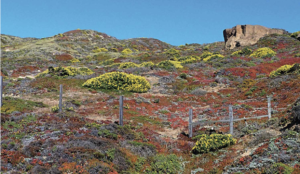
Coastal sage scrub, the habitat of the coastal California gnatcatcher (Wikipedia)
Mission blues inhabit the Bay Area’s coastal chaparral and grassland habitats, such as those found at San Bruno Mountain in northern San Mateo County. Adults drink the nectar of flowers from plant species such as golden asters, buckwheat, and wild hyacinths while caterpillars eat only lupine.
The mission blue has a fascinating life cycle. Adults can be observed fluttering among chaparral and grassland flowers from about late March to early July. Each adult lives only about a week, a fleeting moment in the sun during which to secure the existence of the next generation.
Females lay their eggs singly on the leaves, stems, flowers and seed pods of lupines throughout their mating flight. In four to seven days, the eggs hatch into caterpillars, which feed on the inner tissues of the lu- pine. Lupine flowers are entirely consumed. Then the caterpillars crawl into leaves at the lupine’s base, becoming a pupa, which actually resembles the plant.
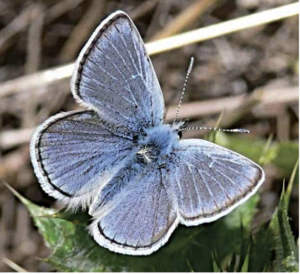
Male Mission Blue Butterfly (US Fish & Wildlife Service
The following spring, the pupa become caterpillars again, tended by ants attracted to a sweet liquid the caterpillars exude called “honeydew”. The ants protect the caterpillars from predators. Each year sees a new generation of mission blues.
Habitat destruction and modification from population-growth driven develop- ment caused population declines of the mission blue that led to its federal listing as an endangered species in 1976. It remains listed today. Most of its remain- ing occupied habitat is now protected as parks and other types of conservation lands. However, the USFWS reports that public infrastructure development still poses a significant threat to its wellbeing.
In addition, a fungal pathogen that infects lupine host plants represents an indirect threat to its survival, as does the prolifer- ation of nonnative grasses and forbs that have invaded its habitat and outcompeted larval food and nectar plants.
As imperiled species dwindle in number and the size of their range shrinks and becomes fragmented, they grow more vulnerable to random factors that would not threaten the survival of larger, more robust populations.
Florida Panther
(Puma concolor coryi)
Another persecuted creature is a listed sub- species that resides in a different Sunbelt state, this one on the opposite side of North America. Florida is also afflicted by rapid population growth and overpopulation. In some ways, it is the East Coast counterpart of California – it too has warm temperatures, crowded sandy beaches, surfing, palm trees, tourists galore, a gigantic Disney theme park, and rampant sprawl and development.
These attributes, plus mild winters and cheap housing, have attracted millions of migrants to Florida from around the country and around the world. At 22 million, Florida is now the third-most populous state in the U.S., trailing just California and Texas, and in recent years, only Texas has piled up more new people every year than Florida has.
The Florida panther, Florida’s official state animal, is a subspecies of the cougar (aka mountain lion, aka puma). It has paid a heavy price for the state’s explosive growth. By the 1970s, only an estimated 20 Florida panthers survived in the wild. The panther stood poised at the brink of extinction’s abyss of oblivion.
Today, after nearly half a century of tons of TLC from wildlife managers, conservation biologists, and an adoring public, those pal- try numbers had increased painstakingly to an estimated 230 panthers by 2017. Compare this to the 57,000 visitors every day to Disney World’s Magic Kingdom in Orlando, the world’s most-visited theme park, and you might get an inkling of just how decisively one large mammal at the top of the food chain has displaced another large mammal and apex predator in Florida.

Florida Panther
The Florida panther now clings to existence only in southern Florida, in impenetrable, mosquito-infested swamplands, hardwood hammocks, and pinelands like those found in Big Cypress National Preserve and adjoining Everglades National Park. The National Wildlife Federation writes that this subspecies “is so critically endangered that it is vulnerable to just about every major threat.” That’s what happens when your numbers drop so low: your vulnerability to potential risks skyrockets.
In addition to habitat loss, other threats to the still-puny Florida panther population to- day are automobile collisions and territorial aggression between panthers, an indica- tion that they have exceeded the carrying capacity of their available habitat. The major implication of that is that the panthers need more suitable habitat than is currently or will be made available in overpopulated Florida.
Exposure to manmade chemicals in the en- vironment – such as herbicides, fungicides, and insecticides used heavily in agriculture – has impaired Florida panther breeding, and of course, with such small numbers to work with, inbreeding and genetic impover- ishment is also a problem. Genetic diversity within a given species is as important a com- ponent of biodiversity as genetic diversity between similar and different species.
Keck’s checkerbloom
(Sidalcea keckii)
To biodiversity conservationists and wildlife biologists, “wildlife” refers not just to the wild animals of the popular imagination but to wild plants as well. Plants too constitute wild lifeforms, communities of organisms living in the wild kingdom.

Keck’s checkerbloom (Pamela Bateman)
Keck’s checkerbloom, a dicot (with two embryonic leaves or cotyledons), is an annual herb in the mallow family. It is both native to California and endemic (limited) to California, occurring around the edges of the Central Valley, both on the inner side of the Coast Range and on grassy slopes in the foothills of the Sierra Nevada. It occurs nowhere else in the wild.
After having been collected and described by botanists in the 1930s, Keck’s check- erbloom was not collected or observed again for over half a century. It was there- fore presumed extinct until it was redis- covered in 1992 at a site in Tulare County. This history exemplifies a phenomenon that characterizes the documentation, management, and conservation of many imperiled species of plants and animals: the difficulty of simply locating them when they have become so scarce.
The USFWS indicates that Keck’s checker- bloom is threatened by urbanization in the Central Valley, competition from non-native and invasive grasses, agricultural land conversion, grazing, and random events. Non-biologists often understandably view farmland in a positive light because it is both scenic open space and because it produces the food we eat.
Yet nationally and globally, the conversion of wildlands to farmland has enormous negative impacts on wild flora, wildlife habitat, wildlife populations, and biodiver- sity because it occurs on a colossal scale (much greater than the scale at which urbanization takes place) and because the natural habitats on which wild plants and animals depend are transmogrified into chemically-treated monocultures of non-native plants that usually offer little or no food or other value to native wildlife. If wild animals do eat or damage food or forage crops intended for our consump- tion (or consumption by our livestock), they are frequently subjected to lethal control methods – trapping, shooting, poisoning – for their “depredations”.
The Sierra Foothill Conservancy has used a combination of private and federal funding sources to buy land and purchase conservation easements to protect the Keck’s checkerbloom. These efforts are commendable, and let us hope they are not too little and too late to save this attractive species.
Ivory-Billed Woodpecker
(Campephilus principalis)
The American Bird Conservancy has a web- page devoted to the legendary ivory-billed woodpecker, at one time – and perhaps still – the largest woodpecker in North America. This summary banner sits right at the top of the page: Population: Unknown; Status: Critically Endangered; Trend: Probably extinct.
Bird lovers and wildlife biologists – myself included – don’t want to accept that the storied ivory-billed woodpecker is probably extinct – gone forever – because it is too painful a prospect. Years ago, I had a pro- fessional colleague who was a migratory bird expert with the U.S. Fish and Wildlife Service in Minnesota. On his vacations, he led crews of determined birdwatchers on excursions into the bottomland hardwood swamps of the Apalachicola River basin in Florida’s panhandle in pursuit of the “Lord God Bird,” aka the ivory-bill. He also wore a baseball cap emblazoned with a silhouette of the ivory-bill and the phrase “I Want To Believe”, a reference to the popular nineties cult television show The X-Files.
Or look how celebrated birder and author Kenn Kaufman responded, in a 2020 inter- view with Audubon magazine, when asked if the ivory-billed woodpecker is extinct: “I have an easy answer for that: yes and no.” After a long explanation as to why he thinks it probably is extinct, Kaufman added:
“What if someone shows up tomorrow with clear and current photos, with unam- biguous video of a living Ivory-bill? I’ll tell you this: I would be thrilled to be proven wrong. I would be overjoyed. I would dance in the streets. I wouldn’t even care about going to see the bird myself; just knowing it still lived would make that the happiest day of my life.
“That’s why I answered the question ‘yes and no.’ My head says that the species is extinct, but my heart won’t accept that.”
One day in 2005, I was facilitating a con- servation planning workshop for Lacassine National Wildlife Refuge staff in the bayou country of southwestern Louisiana when we received word of a news conference underway at that very moment in the National Press Club in Washington, D.C. Secretary of the Interior Gale Norton and ornithologists from the Cornell Lab of Ornithology in Ithaca, New York were announcing evidence for the rediscovery
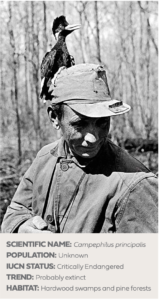
Ivory-billed woodpecker nestling perched atop J.J. Kuhn’s hat at the Springer Tract in Louisiana, 1938. This was the only ivory-bill ever banded as part of the U.S. Fish and Wildlife Service’s leg- banding program (a continent-wide, international conservation initiative for many species). Its leg band was numbered 1; sadly, there was never even a number 2. No other birds of this species were ever located on which to place a leg band. (photo by James T. Tanner)
of the long-lost ivory-bill in the so-called Big Woods of eastern Arkansas, on another national wildlife refuge named Cache River, close to the Mississippi River.
I was jubilant. There hadn’t been a con- firmed sighting of the ivory-bill since the late 1930s in Louisiana. But the next year brought nothing but disappointment and disillusion, as the claim of the Cornell re- searchers was challenged by other experts and could not be replicated unequivocally in field investigations by other ornithologists.
The sad and contentious story of whether or not the ivory-billed woodpecker contin- ues to cling to existence or has plunged over the edge into the ultimate void of nothing- ness illustrates the difficulty that scientists face in declaring a species officially extinct. Some species thought to have vanished permanently have indeed been rediscov- ered, rescued, and recovered.
The case of the passenger pigeon is very unusual. Here an entire species disap- peared from the face of the Earth – and was declared extinct – when the last known survivor, a captive female named Martha, was found dead on the bottom of her cage in the Cincinnati Zoo in 1914.
Never an abundant bird, the ivory-billed woodpecker once inhabited virgin, old- growth bottomland hardwood forests and swamps that used to extend unbroken
in a vast swath across the southeastern U.S. These large birds foraged over wide areas of forest – estimated at almost 10 square miles per nesting pair – seeking food for themselves and their offspring; even in healthy, stable populations, they would have occurred in low numbers. The ivory-bill used its powerful bill to peel bark off dead and dying trunks and limbs in search of insects. In particular, it was fond of plump wood-boring beetle grubs; indeed, the name of its genus – Campe- philus – signifies “lover of grubs.”
By the close of the 19th century, and even more so by the middle of the 20th, the fabled forests of bald cypress, red maple, black gum, water tupelo, and live oak in which the ivory-bill made its home had largely disappeared. They were obliterated by loggers meeting the growing, voracious demands for timber, pulp, and paper from an ever-increasing human population, and by farmers clearing lands for agriculture to furnish more food for more human mouths. The ivory-bill vanished along with the disappearance of the forests that sheltered and nourished them.
Now, whether or not stragglers of this glorious species still endure in one or more isolated forest haunts, the ivory-bill has come to symbolize the plight of all birds and beasts struggling to survive in the human-dominated Anthropocene. Among other ignoble features, the Anthropocene is marked by the sixth major extinction event since the “explosion” of multicellular life on Earth some 541 million years ago at the dawn of the Cambrian Period.
What Wildlife Is Up Against
A 2019 study by scientists from Conser- vation Science Partners identified urban, agricultural, energy, and transportation stressors as the major causes in the loss and fragmentation of natural habitat in the lower 48 states. Incessant population growth, of course, aggravates each of these stressors.
More people need more urban land for their homes. They require more cropland to grow the crops that become the food they
eat. More people necessitate more energy production and consumption, hence more land for natural gas and oil exploration and development, coal mines, wind and solar farms, hydro-electricity on rivers, and so on. More people use more vehicles that require more road capacity.
It all adds up. Numbers mount. Manmade stuff accumulates and clutters the land- scape, altering and eliminating the natural habitats that wildlife depends on.
The 2019 Conservation Science Partners study found that expansion and intensifi- cation of land uses in the U.S. resulted in a steady, inexorable loss of natural areas between 2001 and 2017. In just those 16 years alone, more than 24 million acres of natural habitats were permanently modi- fied or lost to development.
Just how substantial this loss is can be grasped by comparing it to the combined area of three of California’s most iconic national parks in the Sierra Nevada moun- tain range, our “crown jewels”: Yosemite, Sequoia, and Kings Canyon. Their com- bined area is 1.6 million acres.
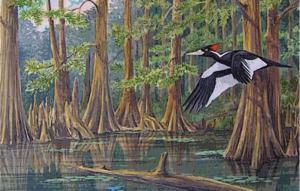
Illustration of an ivory-bill in its habitat (Julie Zickefoose)
Thus, in just 16 years, the area of natural habitat needed by wildlife that was lost to or damaged by one kind of popula- tion-related development or another was 15 times greater than the area of natural habitat protected by these three large national parks in California.
Unless we succeed in slowing and then stopping population growth, that is, in stabilizing human numbers, rampant, habitat-destroying development will continue dispensing with the wild species that have inhabited this continent we call North America for far longer than humans have. What gives us that right?
When All Is Said and Done
A few years ago I was invited to contribute a chapter on biodiversity and overpop- ulation for the forthcoming University of Georgia Press book entitled Life on the Brink: Environmentalists Confront Overpop- ulation, edited by Phil Cafaro of Colorado State University and Eileen Crist of Virginia Tech. My chapter was called “Overpopula- tion versus Biodiversity: How a Plethora of People Produces a Paucity of Wildlife.”
Towards the end of my essay, I cited a syndicated newspaper column called “The Global Citizen” written by the late Donella Meadows, lead author of the 1972 book The Limits to Growth, based on computer simulation modeling of complex systems at MIT supported by the Club of Rome. In “ 1999, on the 50th anniversary of the 1949 conservation classic A Sand County Almanac, Meadows’ “Global Citizen” column was a tribute to the author of Almanac, the renowned conservationist Aldo Leopold, a pioneering wildlife scientist and wilderness advocate.Meadows wrote in her column that while environmentalists are sometimes accused of being misanthropes (hating humanity), Leopold was most certainly not that. Instead, he considered human beings to be the only living things endowed with the capacity to appreciate creation, or nature, and to comprehend our organic connec- tion to it all.
Meadows recounted how Leopold was once asked to deliver remarks at the dedication of a monument to the extinct passenger pigeon, a bird eliminated for- ever from the face of the Earth by human short-sightedness and greed. The very last pigeon, as noted above, was a female given the plaintive name of Martha, who died all alone in her cage in the Cincinnati Zoo on September 1, 1914.
Leopold’s remarks, as quoted by Meadows, are compelling: “For one species to mourn the death of another is a new thing under the sun. The Cro-Magnon who slew the last mammoth thought only of steaks. The sports man who shot the last pigeon thought only of his prowess. The sailor who clubbed the last auk thought of nothing at all. But we, who have lost our pigeons, mourn the loss. Had the funeral been ours, the pigeons would hardly have mourned us.”
And I finished my essay with these very words:
“Our species is unique, because here and now only we have the ability to destroy, or to save, biodiversity. Only we have the ability to care one way or the other. The destiny of all wild living things is in our hands. Will we crush them or let them be wild and free? Limiting human population will not guarantee success,but not doing so means certain failure.”

